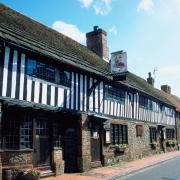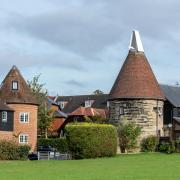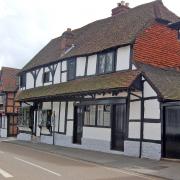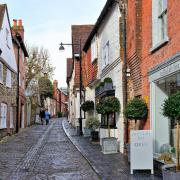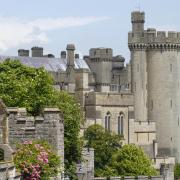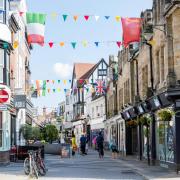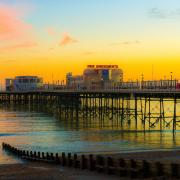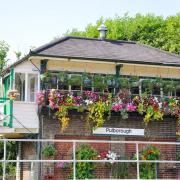Hidden behind an unassuming shop front in Lewes is an historical treasure trove. Duncan Hall peeks into the Reeves Archive ahead of its World War I exhibition

In July the increased UV light and high temperatures through a restored glass roof on Oxford’s National History Museum threatened to destroy the institution’s collection.
It was a timely reminder of how easy it is to lose a priceless collection through sheer miscalculation. But there is a flipside – when all the planets seem to align to keep a collection intact and perfectly catalogued almost by accident. And this has been the case with Lewes’ Edward Reeves photography studio in High Street. Started by Tom Reeves’ great-grandfather in 1855, the studio has remained in the same location since 1858. Down a winding corridor to the same studio space used by four generations of the same family is a seemingly unimportant door. It leads to the archive which has got photographic historians excited. Within its cool confines are double-stacked racks of cardboard boxes packed with hundreds of thousands of negatives and glass plates which have all been meticulously catalogued in a series of ledgers dating back more than 150 years.
The fact the studio has remained in the same location meant no-one ever chose to reduce or break up the collection for ease of movement. A decision by one of Tom’s forefathers not to use nitrate negatives – which can degrade and become highly flammable over time – meant the archive wasn’t at risk to a blaze as happened in 1991 to Kolkata’s Bourne and Shepherd studio which lost items dating back to 1840. The chalk land which the studio is built on acts as a natural desiccant, keeping moisture levels on an even keel, while the location at the peak of Lewes’ steep High Street meant the studio avoided flooding in 2000. “The family story is that we moved here because the vibration of the trains under the tunnel in the previous studio was upsetting his exposures,” says Tom.
“Great-grandfather chose his spot well,” laughs Brigitte Lardinois, senior research fellow at the London College of Communication, who first encountered Tom’s studio four years ago. She is now leading a 30-strong volunteer team digitising the ledgers on Excel spreadsheets as the books are at most danger of being destroyed by time. “I didn’t realise the vast majority of archives survive without their paperwork,” says Tom. “It means with all our photographs we have the date it was taken and a little bit about the customer.”
Brigitte is also applying for funding to ensure the still-growing archive is both fully explored and survives, working with the help of Imperial War Museum curator of photography Hilary Roberts.
“As a photo-historian I have confidence in saying it is the oldest still-surviving studio run by the same family on the same premises in the world,” says Brigitte. “It is of great historical importance for the history of photography itself. We need to make sure it is still here in 80 years.”
What makes the Reeves Archive fascinating is its sheer ordinariness. Edward and his descendants didn’t spend their time taking photographs of celebrities, or travel the world capturing great vistas and natural wonders. They were, and still are, the studio of choice for Lewesians to get a family photo, a passport shot or a photographic keepsake. The archive has a complete photographic record of every production staged by the Lewes Operatic Society dating back to 1913, every town mayor from 1893 and many early Glyndebourne productions.
“We have 150,000 portraits which range from 1850 to now,” says Tom, 55, who took over the studio from his ailing father in 1982 fresh from taking a photography degree.
“In that era if you wanted a picture you had to go to a photographer. The archive is a reflection of what commissioned photography has been about over the years.”

“There are families which have returned again and again,” adds Brigitte from the same studio space where Tom and his ancestors have taken the majority of their portrait shots. “There’s a huge amount of commercial work – street scenes, estate agent pictures and shots for local industry photographing their products.”
“You never know what is going to be interesting in 100 years’ time,” points out Tom. “We did a lot for Phoenix Ironworks, which did the railings along Brighton seafront and the city’s bus shelters. There are pictures of them being made. Another 100 years on a picture of a drain cover is fascinating!
“The frustrating thing is every picture must have had a reason why it was commissioned – and we are never going to know the back story to some of them.”
The story is a little more obvious for the archive’s latest exhibition. The archive had already been trawled for pictures of Lewes shop fronts in 2014 and 2015. They were displayed on 80 lightboxes in the windows of the respective businesses in two exhibitions entitled Stories Seen Through A Glass Plate.
But to mark the centenary of World War I they decided to do something special.
“The original idea was to research the names on the Lewes War Memorial and place any portraits we had on the homes of those who never came back,” says Tom. “It would have been a bit heavy. The exhibition expanded into being about Lewes during World War I – illustrating there were casualties, but also life was going on at the same time. People were at home, doing their normal jobs.”
There are some sobering aspects of the archive during this period though. “You start to build up a picture of collective loss,” says Brigitte. “There are families with only old men and little boys in the picture – with an absence of young men. There are 273 people listed on the war memorial which is a lot for a small town. As a social history outreach project it is a good way of gently reminding people how horrible it was 100 years ago without having to labour the case.”
As well as pictures of brave young lads heading off to the front, and families torn apart by loss, the photographs document other aspects of wartime life, such as the existence of the Blue Boys. “When wounded soldiers came back to recuperate some were given white feathers for cowardice as people assumed they hadn’t signed on to fight,” says Tom. “So the War Office created this blue uniform to stop it happening. The stories which are coming out of this archive are fascinating.”
It’s not the first time Tom has been commissioned to create a project related to World War I. Last year for a Royal British Legion campaign he recreated images taken by his ancestors of young soldiers heading off to war with modern-day veterans, but using the same studio location and 10x8 plate camera. “The British Legion came to us through the lightbox project,” says Brigitte. “We could use the same background and furniture so the modern soldiers could be in exactly the same place. It was a great series.” The photographs were exhibited at the Bradford National Museum of Photography, which has helped spread the word about the Reeves Archive nationally.
As for the future, Tom and wife Tania Osband’s 18-year-old son Isaac is turning out to be a good photographer and could well be the fifth generation to take the business on.
“My son did his A Levels at Varndean [in Brighton] who still develop prints in dark rooms,” says Tom. “If you’re a photographer you have got to know a bit of the science – what F numbers are for example. My dad used to say every time you click the shutter it’s a shilling!
“There used to be three photographers in Lewes, now there are about 40. I can’t believe they can all make a living.”
Brigitte believes Edward Reeves’ unique selling point is the sense of occasion. “It has become so special to go to a studio, have your portrait taken and get a real print,” she says. “When I walk down that corridor past the archive room I always get a chill thinking about all the people who have walked there.”
Stories Seen Through a Glass Plate: 1916, Lewes Remembers takes place across the town from Friday 28 October to Friday 18 November 2016. A total of 80 lightboxes will be in shop windows along Lewes High Street, with further exhibitions in Lewes Town Hall, Edward Reeves Studio Gallery and the Tourist Information Centre.
The All Saints Centre, in Friars Walk, Lewes, is hosting a public activity day on Sunday 30 October 2016 in association with the Imperial War Museum and University of the Arts London. As well as tours of the lightboxes, the day will include a screening of Battle of the Somme, the first full-length documentary film ever made, at 2pm and 5pm.
All events are free of charge. For more information visit www.reevesarchive.co.uk








